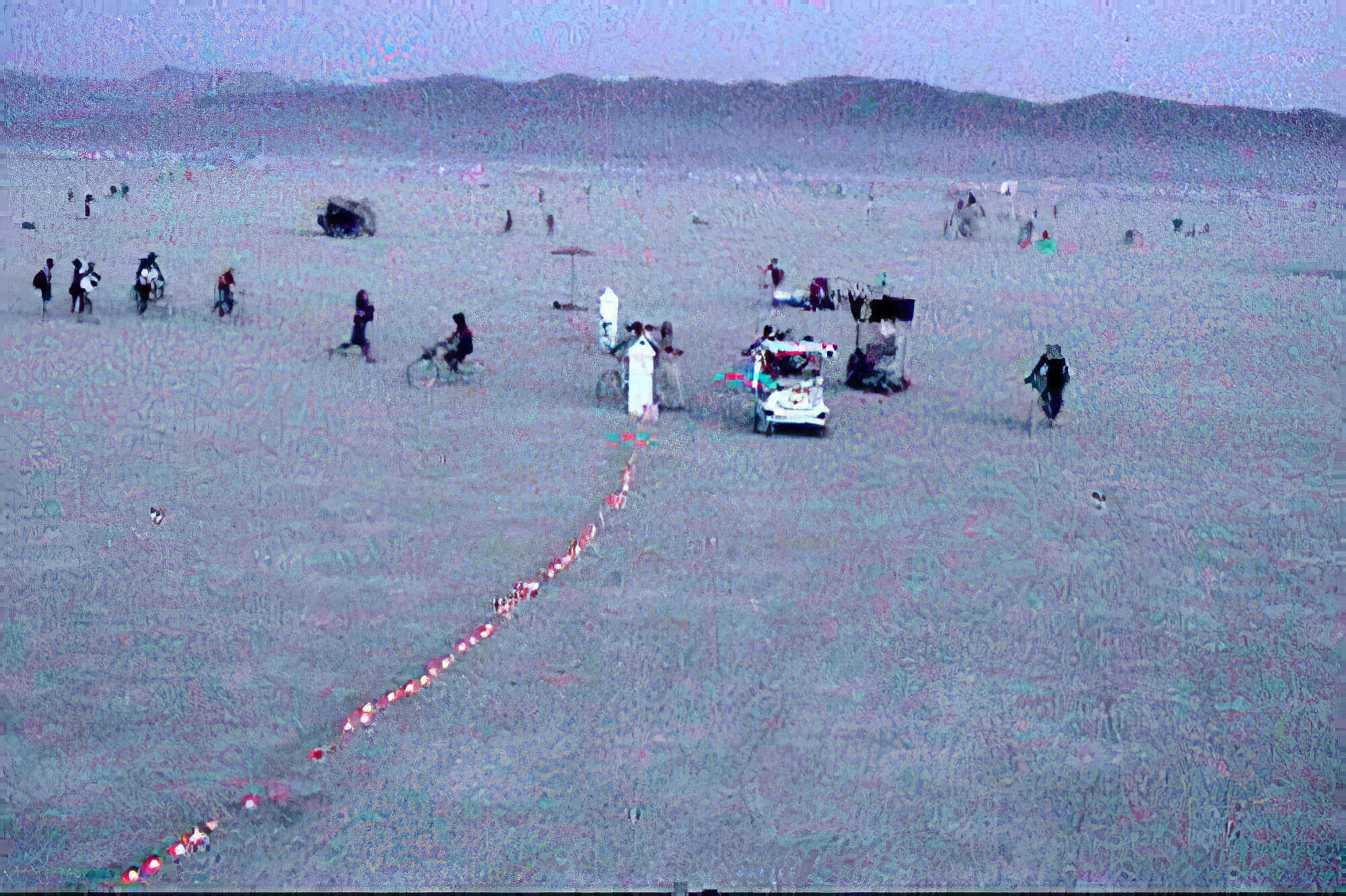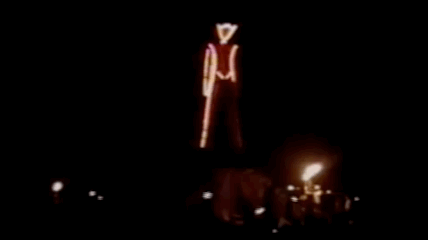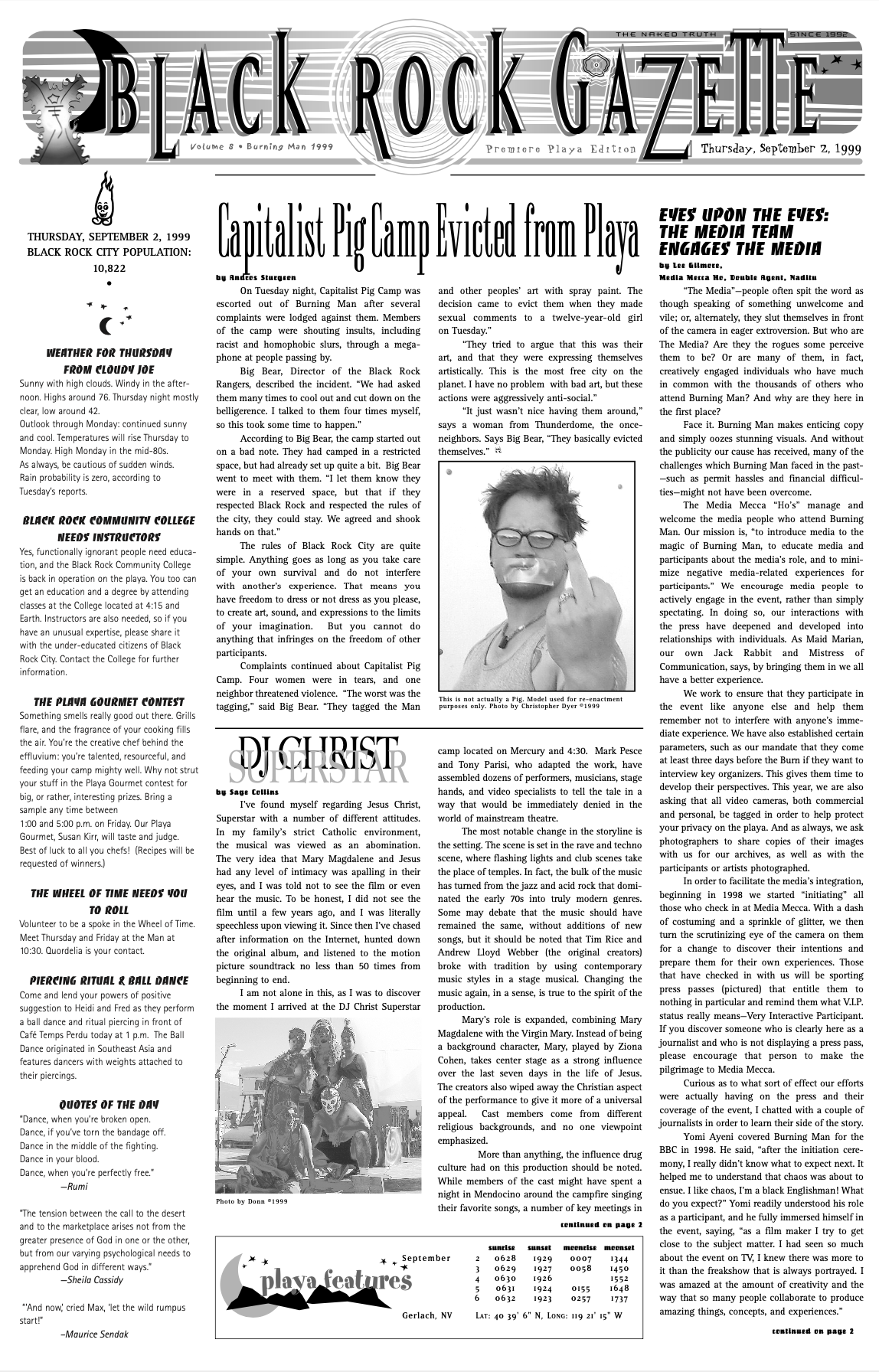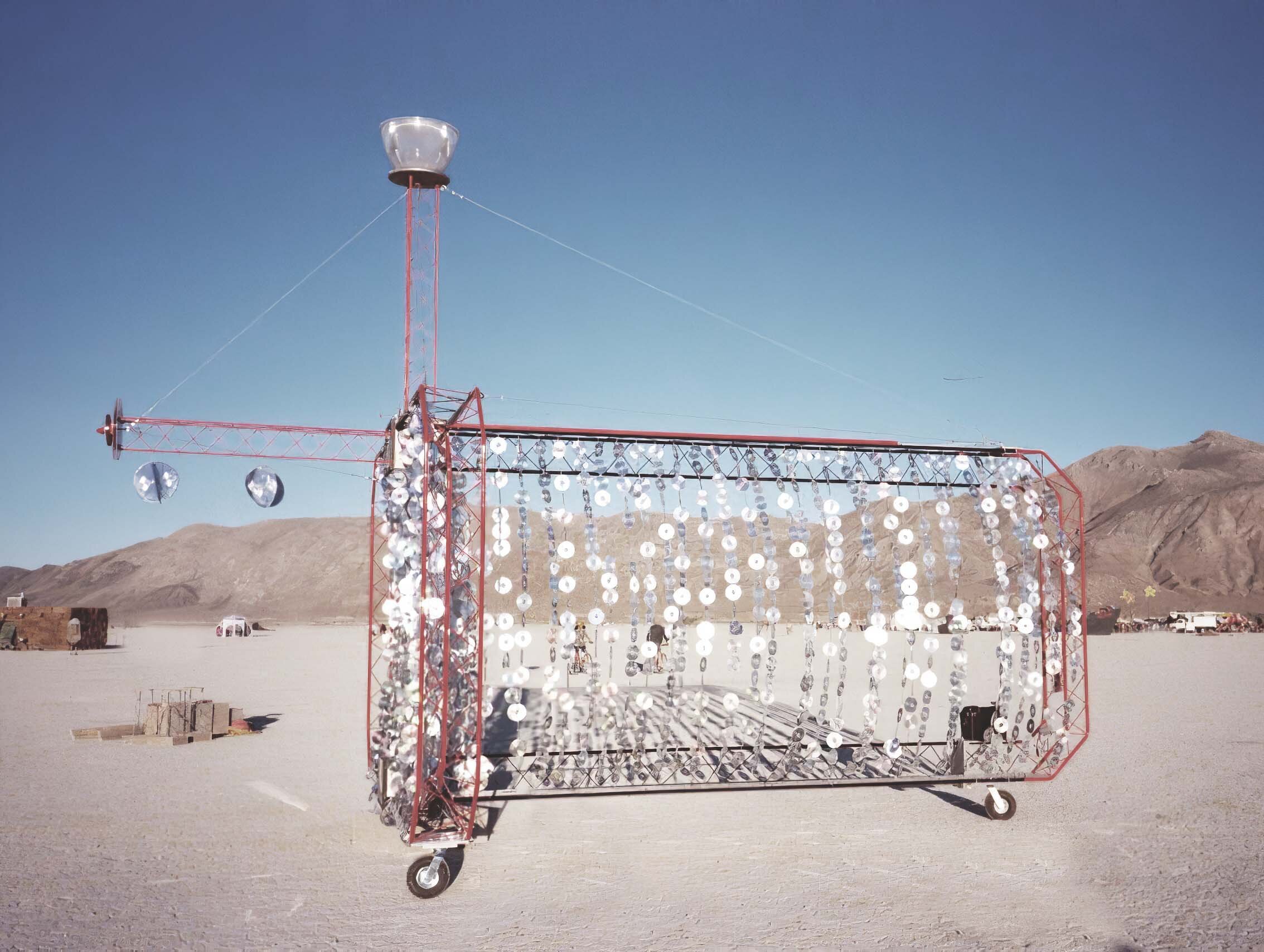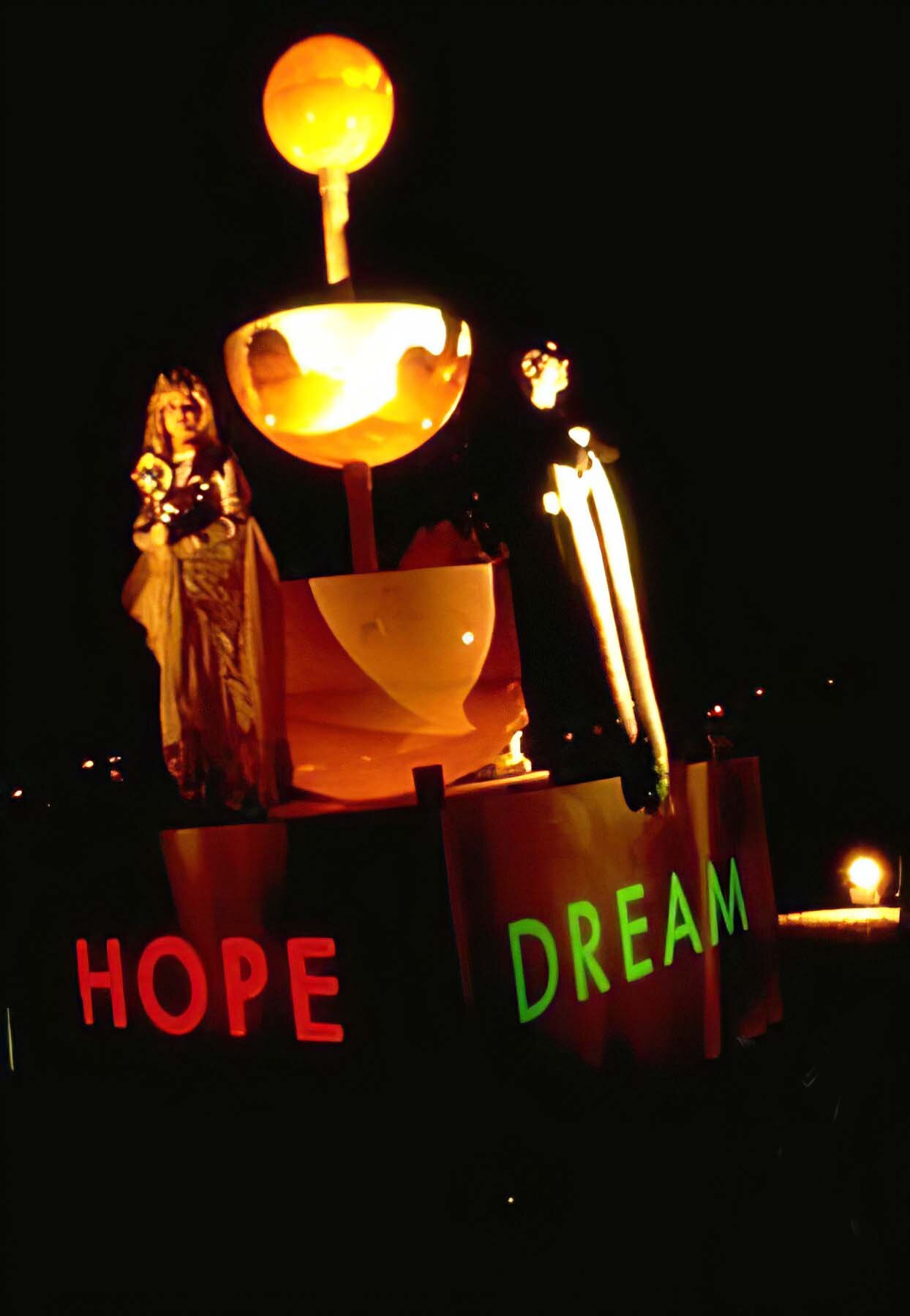Burning Man 1999
Burning Man 1999: The Wheel of TIme
In 1999, Burning Man looked decidedly modern. The modern map was adopted. The Man burned on a Saturday for the first time. 23,000 participants attended, and the event would never again experience the year over year population explosions of past years. The event would flex political muscle for the first time, effectively defeating policies that would have ended the event. The organization would achieve unprecedented financial health, while providing significant financial support to the local community.
BLM Permit and the Fight for Continued Use of Black Rock
The Permit. The 1999 permit was granted without significant resistance. Neither of the local counties opposed the grant of the permit, and relations with local government and the bordering towns were good. In 1999 a proposal arose, which was ultimately adopted, to move away from reimbursement of government expense associated with accommodating the event to a $4 per person fee, resulting in the ability for the government to use resources wisely, and turn a profit on the event.
The organization continued community outreach efforts of past years, including a significant cash donation to Gerlach by donating all funds raised through ice sales. In 1998, the donations were $22,000 and despite much cooler weather in 1999, the donation was slightly higher due to increased attendance.
In addition, in 1999 Burning Man instituted the Highway Cleanup crew, expanding the cleanup beyond the playa to cover the major roads leaving Black Rock.
One point of contention in the permit negotiation was a BLM requirement of a daily trash haul from the Playa. A requirement that re-appeared in the proposed 2019 EIS. However, a compromise was reached, where the org placed dumpsters at the exit for participants to use when the left.
The EIS. Despite the relative ease of obtaining the annual permit, Burning Man was facing a fight for survival. In September 1998, shortly after the end of the 1998 event, the local BLM office released a proposed environmental impact statement (EIS) impacting the long term future use of the Black Rock Desert.
The EIS included a proposal to limit the number of “visitor days” in a year to 40,000 and to cap attendance at any one event to 10,000. A visitor day is calculated as a single person being present in Black Rock for an 8-hour period (or three days per 24-hour period). Therefore, one person staying at Burning Man for five days would constitute 15 visitor days. A 10,000-person event for five days would equal 150,000 visitor days. In short, if adopted, the visitor day cap would end Burning Man at Black Rock.
The argument being put forth is that there must be a “cumulative impact” by people visiting a natural area. The more people, and the more time they spend there, the greater must be the impact. This moves away from actually requiring a measurable impact.
Burning Man, really for the first time, mobilized its participants to push back on the proposal. On October 30, 1998, Marian Goodell sent an email via the Jack Rabbit Speaks mailing list, with a call for action (read it here). It called out issues it saw in the draft EIS, and requested participants to contact the BLM and to attend meetings. She also pointed people to Larry Harvey’s article from earlier in the year over the fight for the desert (read here), as well as a new “interview” with Larry (these were articles written by Larry in the form of a Q&A session).
The lobbying was successful. The BLM not only granted the permit in 1999, eventually the Visitor Day proposal was entirely withdrawn in 2000.
Theme: The Wheel of Time
In 1999, Burning Man’s theme was “The Wheel of TIme”. The implementation of the theme had a lasting impact. First, the layout of the city was created to reflect a clock face. One look at the city map and one recognizes the modern city layout. While more streets have been added, the fundamental map has not changed since.
Looking closer, one also notices the street numbering system also reflects the current system, using a time system that originated in ‘99 for radial streets. Circumferential streets were named after the planets, loosely relating to the theme of time, as well. In ‘98, the theme was the Nebulous Entity, yet the streets were named after Monopoly properties, Atlantic and Baltic.
Participants were encouraged to pinpoint their locations “by subdividing these units into minutes or even seconds. A sample address: 5:24 Mars. All participants will be encouraged (during daylight hours) to celebrate the time when it arrives at their particular address. Thus we will construct a clock around a clock, transforming Black Rock City into a living timepiece.” Twelve major installations mapped at the hour locations just off the Esplanade.
The Theme: Art and Performance Plans
In 1999, the org intended the space near the man to “become a large-scale gallery and performance space featuring time-related art.” Larry Harvey expanded upon this idea:
Building Burning Man 1999
The final edition
The Man will stand upon a boundary that divides this circle into two great temporal hemispheres. All art located forward of the Man will portray our local neighborhood in time. The quadrant that is located between 6 and 9 o'clock will be devoted to a consideration of our immediate foreground in the past, the 20th Century, and the quarter of our dial between 6 and 3 o'clock will address our imagining of the future. That half of this circle located behind Burning Man will be called "The Primordium", and will represent remoter reaches of the past. It will arc backward in a great curving continuum toward 12 o'clock, our farthest point of travel and the source of Time itself. Individual installations will be sited on the grid work of our clock according to their temporal relationship with other works of art. A detailed map will be provided to participants to guide them as they navigate the longitudes and latitudes of this spatio-temporal landscape.
Larry also envisioned a grande performance piece to the theme, which you can read about here.
1999 Burning Man Street Sign | Photo: Wybread.com
On Friday night we staged a series of performances, starting at 6 PM, at the 6:00 position. Dana Albany’s Bone Tree led participants around the clock face, where a performance awaited them every hour, on the hour. Of course by about 3AM it was freezing, and the weather put an end to our grand cavalcade of performances. We did learn, however, that arranging the art installations in some sort of logical pattern added theatrical significance and prominence to the art.
Christine "Ladybee" Kristen - Placing Art in Black Rock City
The Event
Burning Man 1999 Gate Sign | Photo Wybread.com
The event was the coldest to date and windy. Despite the larger size of the event, relations with law enforcement were described as significantly improved. Gone was the circling helicopter of 1998, and arrests were around half of the prior year (seven total, one gate crasher, one assault, one weapons charge and the rest drug sales arrests). Brian Doherty describes the détente with law enforcement:
No one wants to say it flat-out, but a policy of looking the other way--or, as Michael Michael puts it, "respecting Black Rock's community mores"--seems in effect regarding drugs, lewdness, and indecent exposure. That won't sound good to either the media or concerned constituents in the counties, so it is left unsaid. When I begin asking a county sheriff about the possibility of an official "see no evil" policy, he cuts me off before the heresy is even fully out of my lips. All laws of the county are enforced to the fullest, he insists. Drug wars demand not only casualties but hypocrisy. Still, to inculcate relaxed policing in a place over brimming with illegal drug use is an accomplishment. Perhaps Burning Man is changing the world.
MTV asked to film an episode of “MTV True Life”. The org eventually denied the request, but MTV still advertised season 2’s second episode as “I’m Going to Burning Man”. However, viewers who tuned in were treated to an episode about computer hackers. The show went to Mardi Gras later in the season.
Can Consumers Escape the Market
Jeff Bezos attended the 1999 event, heightening cries from the community and the scrutiny of the media whether the event had become too much of a tech networking event. And scholars continued to write about their experiences at Burning Man.
The airport becomes, on paper, a permanent air field in 1999, established by pilot Lissa Shoun.
There were around 700 medical cases, most were treating injuries from tripping on rebar or the like, second leading cause was dehydration.
While there was a scramble to get the playa cleaned up after the event, ultimately Burning Man earned public praise for their efforts, including hints that obtaining a permit in 2000 would likely not be a challenge. Organizers recall almost no complaining calls after 1999 event.
While the event overall was peaceful, there were several noteworthy departures from copacetic coexistence.
Disgruntled Postal Workers
Some Cacophony traditions were long gone, such as the drive by shooting range. Another tradition that ended in 1999 was Java Cow’s coffee service, which was commemorated on the face of the 1995 ticket, the only ticket to have featured a photo of a participant, Java Cow (Kimric Smthe).
While most of the conflict between the founding Cacophony members and the continuing event were in the past, 1999 had one final hiccup. Brian Doherty describes the conflict:
With its ever-increasing rules, Burning Man is not the cacophonous event of years gone by, though representatives of the Portland, Oregon, and Los Angeles branches of the Cacophony Society attended in 1999. The L.A. group returned after a two-year absence, bridling at new rules restricting the unsupervised use of pyrotechnics in art projects. The Portland group's anarchic, snarky energy is less suited to the festival than it once was. The real cops quickly put the kibosh on their routine of wandering around in postal uniforms with unloaded, but real, guns as the "Disgruntled Postal Workers."
After that cease-and-desist order, the Portland contingent turned its energy to pranking the festival itself, staging a bogus "Larry Harvey" book signing in center camp. One of their number donned a fedora and stuck a cigarette in his mouth--Harvey's signature accessories--and sat on a couch on the mobile living room art car. Supplicants were forced to kneel at gunpoint before "Larry" as he signed cheap, thrift-store paperbacks with xeroxed cover stickers identifying the book as Mein Camp, by Larry Harvey. "Do not touch Mr. Harvey, do not speak to Mr. Harvey, do not look at Mr. Harvey," a gunman shouted through a megaphone. "Move along."
Explosion
On Friday at 11:30 a.m. an explosion went off, leaving a 3-foot crater. It was outside the city perimeter, but close to the Washoe policemen's camp. Brian Doherty described the event in his article for Reason, Burning Man Grows Up
Rumors flew that the U.S. Bureau of Alcohol, Tobacco, and Firearms had been called in, that undercover agents were roaming the city seeking loose lips, that military helicopters deposited men with Dr. Seuss hats and colorfully decorated bikes to blend in. A BLM officer solemnly (and mistakenly) informed a group of Burning Man participants that the explosive was ammonium nitrate, the stuff used in Oklahoma City. That started questions about militia activity and terrorist attacks.
Ultimately, a $3,500 reward was offered, and no suspects were found. Talking to those present in 1999, there is a decisive split between those who believe this was act design to cause damage and a harmless prank. Those who believe there were nefarious intentions, also discuss snipers being found
Capitalist Pig Camp
Just two days after setting up in another camp’s reserved spot, “Capitalist Pig Camp” was thrown out of Burning Man, the first such eviction. Members of the camp were shouting racist and homophobic slurs through a megaphone, tagging art with spray paint, including the man.
The Black Rock Rangers intervene several times, from initial illegal set up on. The final decision to evict followed their making sexual comments to a young girl (either 6 or 12 years old depending on the source).
The Black Rock Gazette (see image) reported:
Big Bear, Director of the Black Rock Rangers, described the incident. “We had asked them many times to cool out and cut down on the belligerence. I talked to them four times myself, so this took some time to happen.” According to Big Bear, the camp started out on a bad note. They had camped in a restricted space, but had already set up quite a bit. Big Bear went to meet with them. “I let them know they were in a reserved space, but that if they respected Black Rock and respected the rules of the city, they could stay. We agreed and shook hands on that.” [At BRC you cannot do anything that infringes on the freedom of other participants. … Four women were in tears, and one neighbor threatened violence. .. “This is the most free city on the planet. I have no problem with bad art, but these actions were aggressively anti-social.”
The Fire Symphony
Burning Man Grows Up
Jim Mason had become a fixture at the Burn. In 1999, he held what was described as a Fire Symphony. It didn’t go as planned. Brian Doherty describes the mayhem:
Jim Mason's fire symphony, performed in the wee hours of Sunday morning--3 a.m. or so--this year. Mason has five tanks that shoot kerosene jets in the air, arranged in a four-tank circle 100 feet in diameter with one in the center. He has composed a three-movement symphony with musical notes represented by flames of different height and intensity bursting in planned rhythms and patterns from the five tanks. It is a perfect example of an art project that could only be pulled off in the space and emptiness of Black Rock. He conducts, speaking through headphone radio to the five tank operators and their spotters, one of whom is me, who all bear fire extinguishers.
"The Impotence Compensation Symphony will now begin," Mason jokes. It goes off impressively for the first two movements, though falling kerosene starts small fires on the tanks, the empty cracked playa, and a shirt left near a tank. A couple of the ground fires seem threatening, and I'm dashing from my spot on the center tank to help others with my water-pressure extinguisher. I slip in a sheet of kerosene; I right myself frantically. The 100-foot flame jets 10 feet from me are a hot weight crushing down on my skull, palpable, like a brick of fire balanced on my head. I keep patting my hair, certain it's on fire.
Streaks of flame pour down the tank 50 feet behind me. I rush to empty my extinguisher on it, futilely. Someone grabs the extinguisher from my hand. "Run, run, run, it might blow!" Mason is shouting. Performers and crowd form a circle 100 yards wide around the tank, perhaps secretly hoping for one more colorful explosion. Luckily--or alas--the tank, with its nozzle left open, runs out of kerosene before the pressurized liquid explodes.
L2K and The Man Burn
L2K Project
Burning Man 1999
For the first time, Burning Man burned the Man on Saturday night, not Sunday night. In 1999, the Man was circled with an art project called Lights 2000 (or L2k). L2K created by the Mad Scientists, a collective of San Francisco artists and engineers lead by Tim Black. The project consists of 2000 orange light emitting "pods" mounted on the ground in a huge circle, encircling tha Man. Light patterns were programmed sequences but were modified in real time by participants are modified via interactive control panels holding a total of 2,000 push buttons.
The Man Burn, 1999. Neon issues are apparent.
The Man was still being raised at the beginning of the event and then lowered, packed with explosives, and raised with the help of volunteers shortly before the Burn. This year, there were problems with the neon lighting, and the while the crowd was gathering he was still on the ground. The lighting issues were not resolved, and he was raised with only partial lighting.
Exodus
Exodus was slow. High winds created visibility problem. The exits were not well suited for the amount of people, and on Monday a traffic accident at the California/ Nevada border backed traffic up on I-80 into mid-town Reno.
Cleanup
Cleanup took a while. BLM wouldn’t sign off in October due to 200 burn scars. They signed off in November with praise for the organization, including noting there were no implements
Black Rock Gazette | Gate Ed.
The Black Rock Gazette | Thurs.
Black Rock Gazette | Friday Ed
Black Rock Gazette | Sat. Ed.
Black Rock Gazette | Sun. Ed.
Gallery Shows
In 1999, Burning Man was featured in two gallery shows. July 9 to 31, 1999, LadyBee and Jeogh Bullock curated a show, The Art of Burning Man at Bruka Theater Gallery. And in December 11, 1999 to March 12, 2000, Burning Man: Photographs and Neon from Black Rock City, Nevada 1992-1999 was held at the Museum of Neon Art in Los Angles, curated by LadyBee.
1999 Art Installations
Anti Time — Dali Homage
Photo: Erik Lassi
by: Kevin Jorgensen
A place to view some of Dali’s paintings and ideas on time and space. To view the art, one would stand in front of an empty picture frame, and view items on the playa.
Black Hole
by: the v
You will see, be drawn toward, and then enter the mouth of The Black Hole (a 30′ black windsock, secured to the playa floor). Experience your mental projections, crunch your own time/space continuum, become One, and extrude out the very narrow far end.
Buddha Garden
by: Jimbo Blakley
In some still region of the Playa, somewhere out past the Man, you stumble upon eight meditating souls, eight fractured/reflected visions of earth & sky; you stumble upon nothing; you stumble upon yourself.
Burial at Space
Burning Man of Speakers
Photo: LadyBee
by: Scott Amidzich
This 20′ tall man in made entirely of speakers.
Burning Manta
by: Mike Maung
The manta is a twenty foot plywood sculpture of a manta ray in the style of a childs wooden puzzle.
Crashed Spaceship
by: the Free Martian Xenologists
A 10′ tall wooden spaceship has embedded itself in the playa.
Crown of the Desert
David & Goliath
DoUCDLite 2.0
Michael Pedroni
by: Michael Pedroni
Last year’s CD sculpture returns in a more complex form, with several layers of CD curtains.
DNA Strand
Elephant
Photo: Steven Raspa
by: Michael Curry
This life-sized orange fabric elephant was supported by a bicycle.
Fertility Sundial
Fnord
1999 Fnord Photo Margot Duane
Fish Plates
by: Joseph Rut
I dreamed of a field of silver platters supported by rusty iron pipes and heaped with rice and vegetables, crowned with mummified fish carcasses.
FlaMe WoMan
Photo: Philippe Glade
by: Zoomie
Made of 2000 candles and gifted with a great mane of amber hair, FlaMe WoMan looks out of one blue eye with an iris in the shape of a spiral, and sheds a tear from the other. She wears a long blue & green flickering skirt. The core of FlaMe WoMan is a fire pit which receives messages from visitors. Around the core, altars are built by participants, creating a sacred space for rituals.
Golden Goddess
by: Eugene Phillips
The Golden Goddess is a large smiling head, shining brightly in her golden skin. Participants are invited to write a wish on a piece of sacramental paper, which can then be glued to her surface. After she is covered with wishes, we will burn her and send your wishes to the heavens.
Hall of Possible Selves
Hall of Possible Selves, Burning Man 1999 | Photo: Holly Kreuter
By Stephanie Andrews
Stephanie Andrew's "Hall of Possible Selves," 1999, consisted of a ring of transparent columns lined in mylar and photographs. She invited viewers to stand before the columns and to let their reflections blend with the photographs, imagining that they were other people.
H.M.S. Love
by: by Gucci Boy (Andy Hill) and crew
H.M.S. Love is the story of a submarine captain who fell in love. Stalking the dark emotionally cold Atlantic seas of dodgy relationships he met a woman and got giddy with love. It all happened so fast that he surfaced out of control and found himself in a desert. H.M.S. Love is a full size WWII submarine, 50′ in length.
URL: www.gucciboy.com
Junk Yard Ship
Krystl
by: Spencer Tunick
Spencer Tunick’s second annual group nude photograph is made entirely of participants and is part of his Reaction Zone series.
URL: www.spencertunick.com
Lamp Mobile
by: Carl Heiney
A dozen hand-decorated table lamps hang in perfect balance from this 16′ tall spinning metal mobile.
La Mystere de Papa Loko
by: Pepe Ozan
La Mystere de Papa Loko |. Photo: Holly Krueter
Little House on the Playa
by: Terry Shreck and Edwin Basye
This simple haybale house cooled by an evaporative generator provides a quiet shelter from the sun and heat of the playa.
Museum of 10,000 Wonderful Things
by: Noah Lang
Everything that is marvellous carries with it much that is instructive, and, in this sense, The Museum of Ten Thousand Wonderful Things, may be made useful for the highest educational purposes. Events which happen in the regular course have no claim to a place in any museum that professes to be a register of what is uncommon; and were we to select such Wonders only as are capable of familiar demonstration, we should destroy their right to be deemed wondrous, and, at the same time, defeat the very object which we profess to have in view. A marvel once explained away ceases to be a marvel. For this reason, while rejecting everything that is obviously fictitious and untrue, we have not hesitated to insert many incidents and exhibits which appear at first sight to be wholly incredible.
National Desk
by: the Palookaville Institute of Contemporary Art and Mark Van Proyen
This 16′ X 12′ desk towers over participants in this project by San Francisco Art Institute students who created it for Burning Man in a class.
Orbicular Affect
by Chris Campbell
Orbit
Phoenix
by: the Mystic Krewe of Satyrs
A golden 12′ high Phoenix rests on this hand-pulled Mardi Gras style float. The bird breathes fire from her beak and she bleeds wine from her breast, where she has pecked herself to feed her young.
Psyche's Lantern
by: Christine Parise
This lantern serves as a beacon for the soul, an icon of immortality and enlightenment through love. Painted images inside the lantern, based loosely on the myth of Psyche (the woman who became a goddess by the strength of her love for the god Cupid), shine forth from the center, rotating and radiating throughout the desert. Music will emanate from within, beckoning passers-by to sit and delight with each spin of the lantern.
Pteronodon
by: Norm Barringer
A stylized wooden dinosaur spreads its red-lined wings over the playa.
Sands of Time
Photo: BurningMan.org
Sharon's Rising
by: Michael Taluc
Tall wooden towers support red fabric banners which are lit by red lights.
Solar Garden
by: Kevin Gauna
A 30′ X 30′ garden contains fifteen solar-powered copper plants which collect sun energy by day and shine forth by night.
Stan's Room / Submerging Man
by: Finley Fryer
Photo: Philippe Glade
He is a 20-foot high hollow figure of a diver made of multi-colored plastic records illuminated from within giving the effect of stained-glass. Stan is brought to you by Finley Fryer and the same folks who brought us the Chapel of the Burning Book at Burning Man ’98.
Tactile Portal
Tactile Portal | Photo Holly Krueter
by: Anthony Bondi
This human carwash is a long corridor lined with tactile elements including boas, rubber balls, scarces, sponges, brushes, and feather dusters.
Temple of the Attenuated Wave
Tesselated Dodecagon
by: Aaron Ferucci
The Tesselated Dodecagon is a nocturnal refuge from intense sound and light. Straightedge-and-compass methods create a hypnotic pattern of diamonds and squares in the plane.
Tetrahedron
by: Russell Wilcox
The Tetrahedron is a geometric figure described by green laser beams in air, with pyramidal structures and towers holding mirrors to reflect the beams, thus forming the vertices. Six, 20-foot long beams form a four-sided (tetra=four, hedron=sided) pyramid sitting on its edge, which seems to delicately rest on its supports although it’s made of light. It will be possible to walk under The Tetrahedron, as its lowest edge is 10 feet off the ground.
Contact: rwilcox@jps.net
The Big Bang
By Kimric Smythe
The Bone Tree
by Dana Albany
The Bone Tree | Photo by Fin | From Burningman.org
The Futura Deluxe Bubble Fountain and Porta-Temple
“The soundtrack was perfect, birds chirping under an airport-announcer voice spewing out factoids like "in the future, typos will cause cancer. And all the while bubbles were pouring from the main structure. Absolutely beautiful place to sit during sunset, something about it captured a certain part of the trippy isolation of open desert.” ~Japa Kaur
Dream Wish | Photo Kevin Keller
The Futura Deluxe Bubble Fountain and Porta-Temple | Photo LadyBee
The Running Man
by: Dan Ng
The Running Man is a mechanical-kinetic sculpture which creates a semi-realistic illusion of a person running while on fire. The Running Man was built from discarded bicycles and other found metal. He is wrapped in cotton rags and/or kevlar firewick, doused with flammable liquid, set on fire, and then pulled by car, bicycle, or other vehicle. His runs are not scheduled or announced and last for only a minute or two which increases the random and surprising nature of the experience.
The Whale
Time Tunnel
by: Don Syrek
A time portal in the heart of Black Rock City is strategically placed on a sight line between the future and the past. This 80′ long and 30′ wide structure features over 800 rainbow colored lights controlled by a sixteen circuit multi – sequencing solid state control panel. The lights zip back and forth the length of the tunnel in continuously changing patterns. From the inside of the tunnel looking toward the future, one will see the Burning Man in the distance. The time tunnel is the central hub for the Black Rock Taxi Service, the Flying Saucer Space Port, and a number of other art vehicles designed to abduct innocent city dwellers and take them on adventures around the Playa.
Trout Flambe
by: Dirk B. Anderson and Thomas R. Glass
Trout Flambe, constructed of cast iron, cast aluminum, steel, bronze, vinyl and propane, is nourishment for thirsting consciousness, not bodies. The vinyl tube of the skeleton (visible through the partially consumed body) will fill with propane and ignite periodically, leaving a weird impression of a fish skeleton on dark-adapted eyes.
Two by Steve Heck | Photo: LadyBee / Burningman.org
Two
by: Steve Heck
WaterBoy
Photo: Ladybee
by: Marque Cornblatt
WaterBoy is back and this time he’s recruiting. Looking for mermaids, octopi, jellyfish… etc. Lots of water, scuba, snorkeling and more water.
Contact: waterboy@falsegods.com
Walking Maze
Welded Metal Men
by: Byron Chell
In homage to the Man, two 6′ – 8′ tall welded metal interpretations of the man walk the playa.





